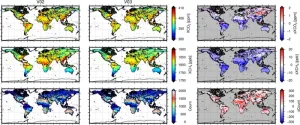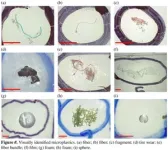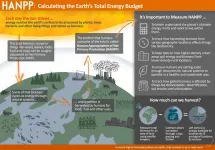Update on the analysis method to estimate the greenhouse gas concentrations from GOSAT
New dataset of the satellite-derived greenhouse gas concentrations
2023-04-18
(Press-News.org)
1. Background and objectives
The Greenhouse gases Observing SATellite (GOSAT) that is the joint mission of the Ministry of Environment, the National Institute for Environmental Studies (NIES), and the Japan Aerospace Exploration Agency has observed almost continuously since its launch and is currently in operation.
Thermal And Near-infrared Sensor for carbon Observation – Fourier Transform Spectrometer (TANSO-FTS) onboard GOSAT observes the shortwave infrared (SWIR) spectra(*1). The carbon dioxide (CO2) and methane (CH4) concentrations can be estimated by analyzing the spectra. NIES publicly provides these concentrations as the level 2 product. In the analysis, the observations with clouds in its field of view are not processed because the atmospheric particles such as clouds and aerosols are the large error sources of the estimation of the greenhouse gas concentrations. The number of data of only several percent is available as level 2 data due to this filtering. The updated analysis method changes the treatment of clouds to make available the scenes contaminated by optically thin clouds. Additionally, the supplemental information was also updated. These updates were performed to aim for the increase in the available data amount of the greenhouse gas concentrations and to improve their accuracies.
2. Methodology
The analysis method to estimate the greenhouse gas concentrations from the SWIR spectra observed by GOSAT developed in NIES estimates the parameters related to aerosols simultaneously to take into account their effects that are large uncertainty sources on the analysis (*2). The updated analysis method was improved to estimate cloud parameters instead of rejecting the scenes contaminated by optically thin clouds. This update enables us to analyze the scenes with optically thin clouds previously excluded in the processing. Additionally, we updated the sensitivity degradation model of TANSO-FTS (*3), solar irradiance spectra, and the database of absorption strength by greenhouse gases.
Approximately 13 years (from April 2009 to December 2021) of the observed spectra from GOSAT were analyzed using the updated analysis method to estimate CO2 and CH4 concentrations. The results were compared with the results from the method before the update, the data from the ground-based FTS network (TCCON), and the data from in situ measurements such as aircraft and ships to evaluate data amount and their accuracies.
3. Result and discussion
Comparison studies of the results using the updated method with the TCCON data or the results using the method before the update reveal that the updated method increases about 13% of the number of CO2 concentration data by approximately the same quality as the method before the update over land. However, the number of data decreased by about 20% with the larger negative biases over the ocean. The number of data on CH4 is approximately the same as CO2. The estimated values of CH4 from the updated method are generally lower and the accuracy is the same or slightly better than those from the method before the update.
It is known that the long-term CO2 growth rate estimated from the CO2 concentrations over the ocean from the method before the update is smaller than that from the in situ measurements. Similar evaluations using the results from the updated method revealed that the decadal CO2 growth rate over the ocean improved from the underestimate of 1.68 ppm/decade to 0.01 ppm/decade compared with that from the in situ measurements.
4. Outlook
The CO2 and CH4 concentrations estimated by the updated method are planned to publish as V03.00. The increase in the data may contribute to the improve the quality of the source/sink product, which is the higher-level product. On the other hand, the V03.00 product has negative biases over the ocean. Therefore, we plan to release the bias-corrected one as V03.05. The biases are possibly due to the fitting accuracy of the spectra (*5). We will continue to improve the method through further analysis to resolve this issue.
5. Annotations
*1: TANSO-FTS observes the spectral region called shortwave infrared (SWIR) near 0.7, 1.6, and 2.0 µm by the band 1 – 3 respectively.
*2: Light incident to the Earth’s atmosphere is reflected by the surface and reaches the satellite. The greenhouse gas observation from the SWIR spectra obtained from the satellite uses the absorption of the light on this path by the gases. Atmospheric particles such as clouds and aerosols change the absorption strength of the gases in the observed spectra through interactions, scattering, or absorption. Therefore, an accurate estimate of the greenhouse gases requires taking into account their contributions.
*3: The radiometric sensitivity in the SWIR band of TANSO-FTS has degraded with time from the launch. That is, the light of the same intensity incoming to the sensor optics is observed as the different intensities depending on the period from the launch. The analysis method to estimate greenhouse gas concentrations developed by NIES take into account this issue by using the degradation model.
*4: The greenhouse gas concentrations estimated from GOSAT and the other satellite are validated with the ground-based FTS network, Total Carbon Column Observing Network (TCCON; http://www.tccon.caltech.edu/) that has approximately 30 observation sites in the world. This dataset has higher accuracy than those from the satellites and is appropriate to use for validation studies.
*5: Greenhouse gas concentration estimates are based on the spectral fitting between observed and theoretical spectra calculated by assuming the atmospheric and surface states. In this procedure, we look for the theoretical spectra consistent with the observed spectra by changing the target parameters such as greenhouse gas concentrations.
END
ELSE PRESS RELEASES FROM THIS DATE:
2023-04-18
The time has come and gone for universal masking in healthcare settings, according to healthcare epidemiologists and infectious diseases experts from healthcare systems throughout Boston and beyond. In a commentary published in Annals of Internal Medicine and co-authored by experts from Mass General Brigham, Beth Israel Lahey Health, Tufts Medicine, the VA Healthcare System Boston, and other healthcare systems across the country, the authors describe the changing context and conditions of the pandemic and outline why universal masking should no longer be required in healthcare settings.
“While critically important in the earlier ...
2023-04-18
Hospital inpatients have better prospects of surviving a cardiac arrest in large hospitals and well-resourced wards, and daytime cardiac arrests are also associated with better chances of survival, a University of Gothenburg thesis shows.
Cardiac arrest means that the heart stops pumping blood. Within seconds, unconsciousness occurs; within minutes, brain cells start dying, causing irreparable damage.
The key to enhancing the patients’ chances of survival is restoring the circulation of oxygenated blood in the body. ...
2023-04-18
A randomised clinical trial is looking at whether faecal microbiota transplantation (FMT) from healthy donors into adults with early-stage amyotrophic lateral sclerosis (ALS – one of the most common forms of motor neurone disease) can modulate the immune reaction during inflammation responses that characterise disease progression, and aims to investigate the relationship between specific gut bacteria and their action on immune system cells.
The preliminary findings by Dr Alessandra Guarnaccia from Columbus-Gemelli University Hospital IRCCS, Rome, Italy and ...
2023-04-18
The steps taken by a London hospital to prevent an outbreak of measles will be detailed at this year’s European Congress of Clinical Microbiology & Infectious Diseases (ECCMID) in Copenhagen, Denmark (15-18 April).
Measles, which is highly contagious, can cause serious and potentially life-threating illness and complications including blindness, encephalitis (swelling of the brain) and pneumonia. Pregnant women, infants and severely immunocompromised individuals are at highest risk.
Contracted when pregnant, it can cause low birth weight babies, premature birth, miscarriage or stillbirth.
It usually starts with cold-like symptoms, followed by a rash a few days later. ...
2023-04-18
AI software can accurately detect TB from chest X-rays, a study being presented at this year’s European Congress of Clinical Microbiology & Infectious Diseases (ECCMID) in Copenhagen, Denmark, (15-18 April), shows.
Tuberculosis (TB) is a major cause of death and disease worldwide. It causes 1.6 million deaths a year, making it is the 13th leading cause of death globally and the second biggest infectious killer, after COVID-19.
In low-resource settings, chest X-rays play an important role in the diagnosis of patients ...
2023-04-18
New research presented at this week’s European Congress of Clinical Microbiology & Infectious Diseases (Copenhagen, 15-18 April) shows how interventions focused on so called ‘supercontactors’ in hospitals and other long term care facilities (LTCF) can optimise infection control and reduce the spread of infectious diseases. The study is by Dr Quentin Leclerc and colleagues at Institut Pasteur and the Conservatoire National des Arts et Métiers (Paris, France).
Hospitals and ...
2023-04-18
Researchers at the University of California, Davis College of Engineering are using machine learning to identify new materials for high-efficiency solar cells. Using high-throughput experiments and machine learning-based algorithms, they have found it is possible to forecast the materials’ dynamic behavior with very high accuracy, without the need to perform as many experiments.
The work is featured on the cover of the April issue of ACS Energy Letters.
Hybrid perovskites are organic-inorganic molecules that have received a lot of attention ...
2023-04-18
Salmonella infections cause about a million deaths a year worldwide, and there is an urgent need for better vaccines for both typhoid fever and non-typhoidal Salmonella disease. New work from researchers at the UC Davis School of Veterinary Medicine shows how memory T cells, crucial for a vaccine that induces a powerful immune response, can be recruited into the liver in a mouse model of Salmonella.
The work was published April 11 in Proceedings of the National Academy of Sciences.
“Understanding the immunology is key to developing a better vaccine,” said Professor Stephen McSorley, ...
2023-04-18
This planet of 8 billion people is bumping up against its ecological limits, and researchers are trying to quantify the effect of human activity on these finite resources. Some keep tallies of how much carbon they contribute to the atmosphere, others measure direct and indirect water consumption or keep tabs on the amount of land that our food habits demand.
Each of these “footprints” offers an estimate of the impacts individuals and institutions have on the wider world, and are useful — but are flawed, according to geographer Chris ...
2023-04-18
Berkeley — Rates of school discipline fluctuate widely and predictably throughout a school year and increase significantly faster for Black students than for their white counterparts, University of California, Berkeley, researchers have found.
A new study published today in the journal Proceedings of the National Academy of Sciences documents for the first time the “dynamic” nature of student discipline during an academic year. Daily rates of punishment across all schools in the study ratchet up in the weeks before Thanksgiving break, decline immediately ...
LAST 30 PRESS RELEASES:
[Press-News.org] Update on the analysis method to estimate the greenhouse gas concentrations from GOSAT
New dataset of the satellite-derived greenhouse gas concentrations





